Labrador Retrievers: History, Origin, and Purpose
The Labrador Retriever, affectionately known as the Lab across the country or Labra in North India, is one of the most popular dog breeds in the world. Originating in Newfoundland, Canada, in the early 19th century, these dogs were initially bred to assist fishermen in retrieving nets and fish from icy waters. Their webbed paws and water-resistant coat made them ideal for this purpose. In the 1830s, the Earl of Malmesbury brought some of these dogs to England, where they were further developed into the breed we know today.
Labradors were officially recognized by the English Kennel Club in 1903 and by the American Kennel Club in 1917. Their friendly nature, intelligence, and versatility soon made them popular as both working dogs and family pets. Today, Labradors excel in various roles, including as guide dogs for the blind, therapy dogs, search and rescue dogs, and of course, as beloved family companions. Their gentle temperament, loyalty, and eagerness to please have solidified their position as one of the most cherished breeds worldwide.
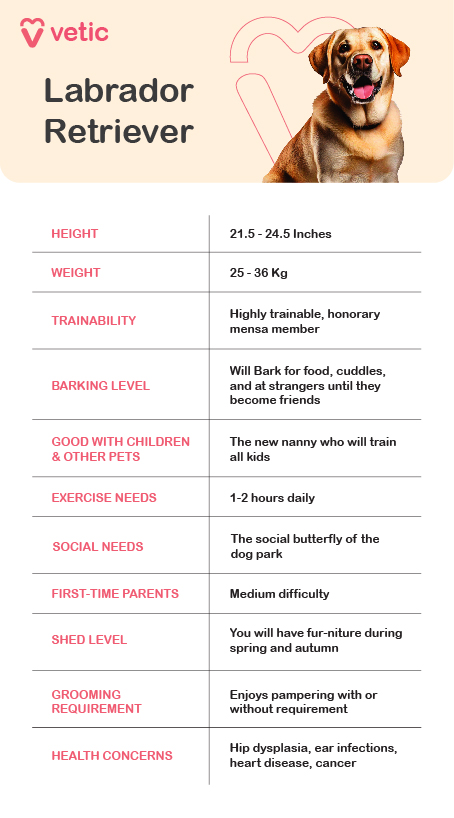
In this comprehensive guide for Labrador Retriever guide for each life stage, we will discuss the following –
- Health Concerns and Disease Predispositions
- Labrador Retriever Puppy: Complete Nutrition, Vaccination and Healthcare Guide
- Labrador Retriever Adolescent: Comprehensive Care Guide
- The Complete Healthcare Guide for Adult Labradors
- Labrador Retriever Senior: Nutrition, Health, Wellness and Preventive Care
Health Concerns and Disease Predispositions
While Labradors are generally healthy dogs, they are prone to certain health issues. Being aware of these can help pet parents take preventive measures and ensure early detection. Here are some of the main health concerns:
- Hip and Elbow Dysplasia: Hip and elbow dysplasia are genetic conditions that affect joint development and can lead to arthritis. Symptoms include limping, difficulty rising, and reluctance to exercise. Regular exercise, maintaining a healthy weight, and joint supplements can help manage these conditions.
- Obesity: Labradors have a tendency to overeat and gain weight easily. Obesity can exacerbate joint issues and lead to other health problems like diabetes. Proper diet management and regular exercise are crucial in preventing obesity.
- Progressive Retinal Atrophy (PRA): This inherited eye disorder can lead to blindness. Regular eye examinations can help detect PRA early. While there’s no cure, early detection can help in managing the condition and adapting the dog’s environment.
- Exercise-Induced Collapse (EIC): This genetic condition causes weakness and collapse after intense exercise. Symptoms include wobbliness and falling over after strenuous activity. Managing exercise intensity and duration can help prevent episodes in affected dogs.
- Gastric Dilatation-Volvulus (Bloat): This life-threatening condition occurs when the stomach fills with gas and twists on itself. Symptoms of bloat and torsion include a distended abdomen, restlessness, and unproductive vomiting. Feeding smaller meals and avoiding exercise immediately after eating can help reduce the risk.
To reduce health risks, pet parents should:
- Consult a veterinarian immediately before or after you bring your puppy home.
- Maintain a healthy diet and weight for their Labrador.
- Provide regular exercise appropriate to the dog’s age and health status.
- Schedule regular vet check-ups for early detection of potential health issues.
- Consider pet insurance to help manage potential healthcare costs.
Labrador Retriever Puppy: Complete Nutrition, Vaccination and Healthcare Guide
Labrador Retriever Puppy: Comprehensive Nutrition Guide
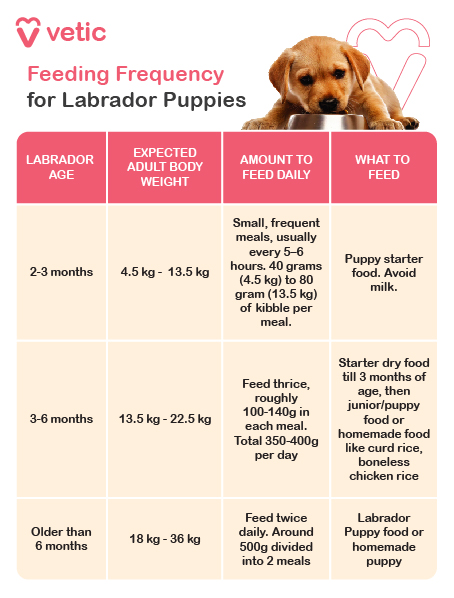
Nutrition for Labrador Retriever Puppies
Labrador Retriever puppies require a balanced diet rich in protein, fats, carbohydrates, vitamins, and minerals to support their rapid growth and development. Since Labradors are prone to obesity, it’s essential to monitor their calorie intake carefully.
Protein: High-quality animal-based proteins like chicken, lamb, or fish are crucial for muscle development.
Fats: Essential fatty acids, particularly omega-3 and omega-6, support brain development, coat health, and overall vitality.
Carbohydrates: Complex carbohydrates like brown rice, sweet potatoes, and barley provide sustained energy.
Vitamins and Minerals: Ensure the diet includes calcium and phosphorus for bone development, as well as vitamins like A, D, and E for immune support.
Food Options:
Commercial Kibble: Choose a high-quality puppy food formulated for large breeds. Brands like Royal Canin and Purina Pro Plan offer specialised formulas.
Wet Food: Provides hydration and is often more palatable, but ensures it’s balanced for growth.
Home-Cooked Meals: If you prefer home-cooked meals, consult with a vet to ensure the diet meets all nutritional requirements. Include cooked lean meats, vegetables like carrots and spinach, and grains like rice.
Feeding Frequency and Timing:
8 to 12 Weeks: Feed 4 small meals per day. Puppies have small stomachs and high energy needs.
12 to 24 Weeks: Gradually reduce to 3 meals per day.
6 Months and Older: Transition to 2 meals per day.
Meals should be provided at the same times each day to establish a routine. Avoid feeding right before bedtime to prevent digestive discomfort.
Preventive Care and Vaccination Schedule
Vaccinations:
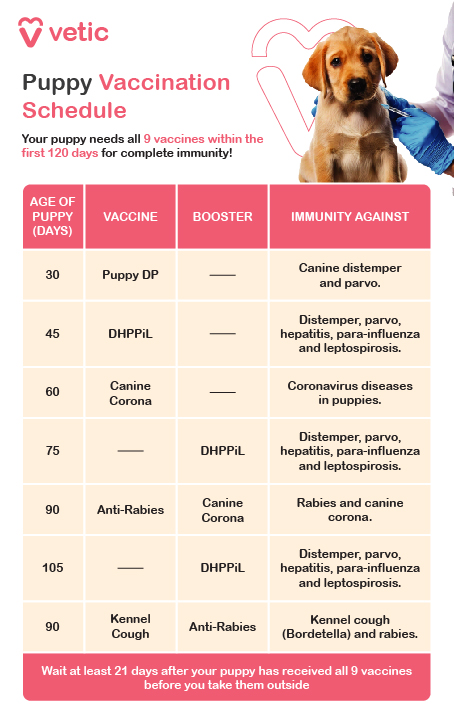
Labrador Retriever puppies need a series of vaccinations to protect them from common diseases.
6-8 Weeks: First vaccinations for Distemper, Parvovirus, and Bordetella.
10-12 Weeks: Follow-up vaccinations for Distemper, Parvovirus, Leptospirosis, Hepatitis, and Parainfluenza. Rabies vaccination may also be given, depending on local regulations.
14-16 Weeks: Final round of core vaccines, including Rabies if not given earlier.
6 Months: Optional vaccines, often imported, depending on your location and lifestyle.
Parasite Control:
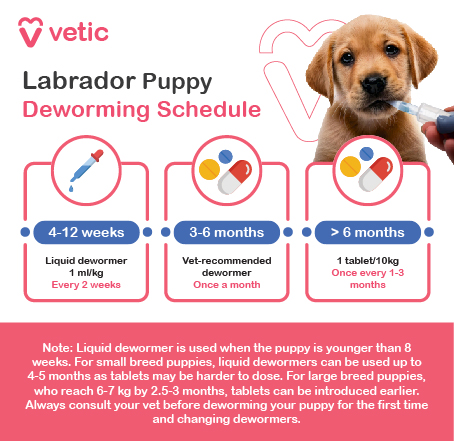
Flea and Tick Prevention: Use vet-recommended topical or oral tick and flea treatments starting at 8 weeks.
Heartworm Prevention: Start monthly heartworm prevention at 12 weeks.
Deworming: Deworm your puppy as per schedule to prevent worm overload. Too many worms can cause diarrhoea, vomiting or even toxicosis.
Regular Vet Check-ups: Schedule regular vet visits every 3-4 weeks during the first 6 months to monitor growth, administer vaccines, and address any health concerns.
Grooming Necessities and Frequency
Coat Care:
Labrador Retrievers have a short, dense double coat that sheds moderately. So, they require occasional grooming.
Brushing: Brush the puppy’s coat 2-3 times a week to remove loose hair and reduce shedding. Use a soft-bristle brush or a grooming mitt.
Bathing: Bathe your puppy once every 1-2 months or as needed, using a mild puppy shampoo. Over-bathing can strip the coat of natural oils.
Ear Cleaning: Labradors are prone to ear infections, so clean the ears weekly with a vet-recommended ear cleaner.
Nail Trimming: Trim the puppy’s nails every 3-4 weeks to prevent overgrowth and discomfort.
Dental Care:
Brush your puppy’s teeth 2-3 times a week with a dog-specific toothpaste to prevent dental issues.
Common Health Risks:
Hip and Elbow Dysplasia: Genetic disorders affecting joint development. Watch for limping, difficulty standing, or reluctance to exercise.
Obesity: Monitor your puppy’s weight and adjust feeding as needed. Obesity can exacerbate joint issues and lead to other health problems.
Ear Infections: Labradors’ floppy ears can trap moisture and debris, leading to infections. Regular ear cleaning and monitoring are essential.
Gastric Dilatation-Volvulus (Bloat): Although rare in puppies, it’s important to be aware of bloat and torsion. These are life-threatening conditions in large breeds. Avoid feeding large meals or vigorous exercise immediately after eating.
Signs to Watch For:
- Sudden lethargy or lack of interest in food
- Persistent vomiting or diarrhoea
- Difficulty breathing or coughing
- Excessive scratching, licking, or signs of discomfort
If any of these symptoms occur, contact your veterinarian promptly.
Labrador Retriever Puppy: Activities, Exercise, and Training
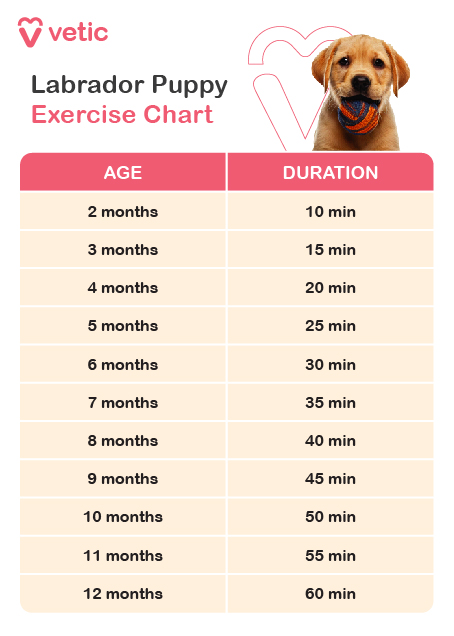
Physical Activities:
Labrador Retriever puppies are energetic and need regular exercise to develop strong muscles and burn off excess energy.
Playtime: Engage in short play sessions throughout the day. Games like fetch, tug-of-war, and hide-and-seek are great.
Walks: Start with short, 10-15 minute walks, gradually increasing the duration as the puppy grows. Avoid excessive running or jumping to protect their developing joints.
Swimming: Labradors are natural swimmers, and gentle swimming can be a great low-impact exercise.
Training:
Begin basic training early to establish good behaviour and a strong bond.
House Training: Start with crate training and take the puppy outside frequently, especially after meals and naps.
Basic Commands: Teach commands like sit, stay, come, and heel using positive reinforcement techniques like treats and praise.
Socialisation: Expose your puppy to various people, animals, and environments to build confidence and prevent behavioural issues.
Mental Stimulation:
Provide puzzle toys and interactive games to keep your puppy mentally engaged and prevent boredom.
Behaviour Problems and Solutions
Common Behaviour Issues:
Chewing: Labrador puppies love to chew, which can lead to destructive behaviour. Provide plenty of chew toys and supervise closely to prevent damage.
Jumping: Puppies often jump up to greet people, which can be problematic as they grow. Teach them to sit before receiving attention.
Barking: Excessive barking can develop if not addressed early. Identify triggers and use training techniques to manage this behaviour.
Behavioral Training Solutions:
Redirection: Redirect inappropriate chewing to a toy and praise the puppy when they use it.
Positive Reinforcement: Reward good behaviour with treats, praise, and attention to encourage repetition.
Consistent Training: Consistency is key. Use the same commands and rewards each time to reinforce learning.
Separation Anxiety:
Labrador puppies can develop separation anxiety if left alone for long periods. Gradually increase the time spent apart and create a positive association with being alone using toys or treats.
Labrador Retriever Adolescent: Comprehensive Care Guide
The Complete Guide to Junior Labrador Nutrition and Feeding
Nutrition for Adolescent Labrador Retrievers
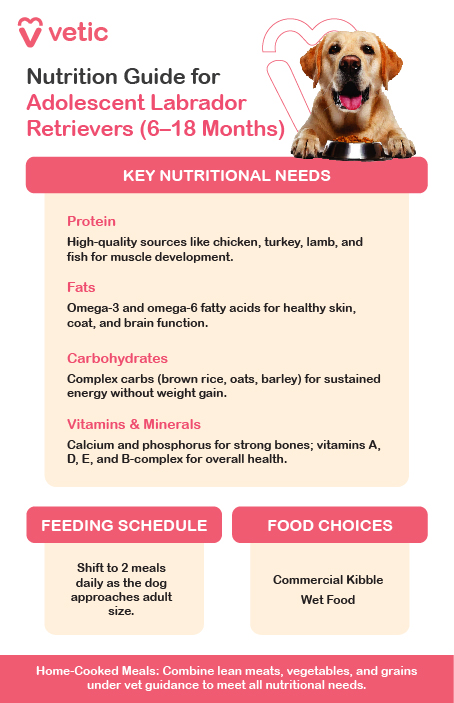
During adolescence, typically from 6 to 18 months, Labrador Retrievers experience significant growth spurts. Proper nutrition is crucial to support their development into healthy adults while preventing obesity, a common issue in this breed.
Protein: Continue to prioritise high-quality protein sources, such as chicken, turkey, lamb, and fish, to support muscle development.
Fats: Essential fatty acids remain important for maintaining a healthy coat, skin, and brain function. Look for omega-3 and omega-6 fatty acids in the diet.
Carbohydrates: Complex carbs like brown rice, oats, and barley provide sustained energy without unnecessary weight gain.
Vitamins and Minerals: Ensure the diet includes adequate calcium and phosphorus to support bone growth, as well as vitamins like A, D, E, and B-complex for overall health.
Food Options:
Commercial Kibble: Choose a high-quality large-breed formula. Brands like Royal Canin, Farmina and Orijen offer appropriate options.
Wet Food: Can be used to supplement dry food, providing hydration and variety. Ensure it’s formulated for adolescent dogs.
Home-Cooked Meals: If preparing meals at home, maintain a balance of lean meats, vegetables, and grains. Consult with your vet to ensure all nutritional needs are met.
Feeding Frequency and Timing:
6 to 12 Months: Feed 2-3 meals per day, depending on the puppy’s size and activity level.
12 to 18 Months: Transition to 2 meals per day as your Labrador approaches adult size.
Establish a regular feeding schedule and avoid feeding late at night to prevent digestive issues. Measure portions carefully to avoid overfeeding.
Grooming Necessities and Frequency for Junior Labradors
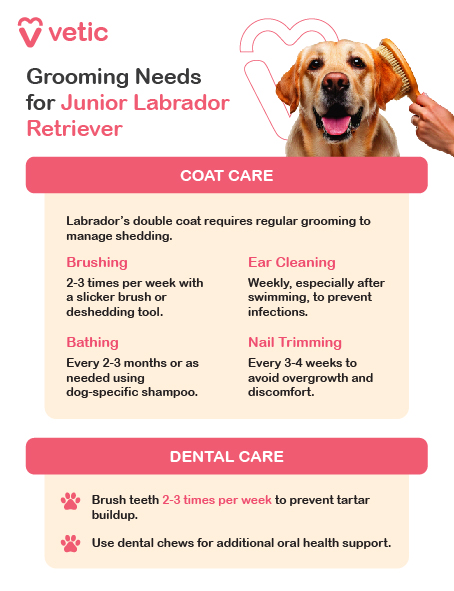
Coat Care:
The Labrador’s double coat will continue to shed, and grooming remains essential.
Brushing: Brush your Labrador’s coat 2-3 times a week to manage shedding and keep the coat healthy. Use a slicker brush or deshedding tool.
Bathing: Bathe every 2-3 months or as needed, using a dog-specific shampoo that doesn’t strip natural oils.
Ear Cleaning: Continue weekly ear cleanings to prevent infections, especially after swimming.
Nail Trimming: Trim nails every 3-4 weeks or as needed to avoid overgrowth and discomfort.
Dental Care:
Brush your Labrador’s teeth 2-3 times a week to prevent tartar buildup and maintain oral health. Dental chews can also be helpful.
Preventive Care and Vaccination Schedule for Labrador Juniors
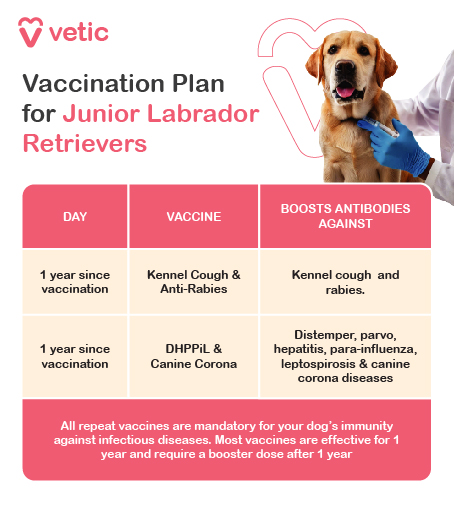
Vaccinations:
By adolescence, most core vaccinations should be up to date, but additional boosters or specific vaccines may be required.
12 Months: Booster shots for core vaccines (Distemper, Parvovirus, Adenovirus, and Rabies) as recommended by your vet.
Optional Vaccines: Depending on your region and lifestyle, consider vaccines for Lyme disease, Bordetella, and Canine Influenza.
Parasite Control:
Flea and Tick Prevention: Continue with monthly tick and flea treatments using vet-recommended products.
Deworming: Give your puppy dewormers as per their age and weight to prevent worm overload. Too many worms can cause diarrhoea, vomiting and even toxicosis.
Heartworm Prevention: Maintain a monthly heartworm prevention regimen.
Regular Vet Check-ups:
Schedule a vet visit every 6 months during adolescence to monitor your Labrador’s growth, weight, and overall health. Discuss any concerns, such as changes in behaviour or appetite.
Common Health Risks and What to Watch Out For
Joint Problems: Adolescence is a critical time for joint health. Watch for signs of hip or elbow dysplasia, such as limping, stiffness, or reluctance to exercise.
Obesity: Labradors are prone to weight gain. Monitor your dog’s weight and adjust food portions as needed.
Ear Infections: Regular ear cleaning is crucial, especially after swimming, to prevent ear infections.
Gastrointestinal Issues: Be mindful of your dog’s diet and watch for signs of bloating, vomiting, or diarrhoea.
Signs to Watch For:
- Sudden weight gain or loss
- Lethargy or decreased activity levels
- Persistent itching, ear scratching, or head shaking
- Changes in appetite or water consumption
- Contact your veterinarian if you notice any unusual symptoms or behaviours.
Labrador Retriever Junior: Training and Behaviour
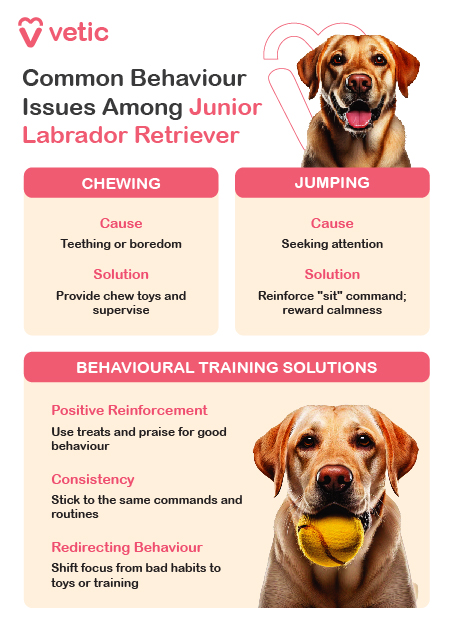
Physical Activities:
Adolescent Labradors are highly energetic and require consistent physical activity to manage their energy levels and prevent behavioural problems.
Daily Walks: Increase walk duration to 30-60 minutes per session, with 1-2 walks per day.
Running and Fetch: Incorporate more intense activities like running or fetch, but avoid overexertion to protect developing joints.
Swimming: Continue to encourage swimming, which is an excellent low-impact exercise that strengthens muscles.
Training:
Training during adolescence is crucial as this is a period when behaviour problems can surface.
Advanced Obedience: Build on basic commands by introducing advanced training, such as off-leash commands, recall, and stay for longer periods.
Socialisation: Continue exposing your Labrador to new environments, people, and animals to prevent fear or aggression.
Impulse Control: Work on impulse control exercises, such as waiting for permission before eating or exiting doors.
Mental Stimulation:
Provide puzzle toys, scent work, and interactive games to challenge your Labrador mentally. This can help reduce boredom and destructive behaviour.
Behaviour Problems and Solutions for Junior Labradors
Common Behaviour Issues:
Chewing: Adolescent Labradors may chew due to teething or boredom. Provide appropriate chew toys and supervise closely.
Jumping: Adolescents may continue to jump up on people for attention. Reinforce the “sit” command and only reward calm behaviour.
Behavioral Training Solutions:
Positive Reinforcement: Continue using positive reinforcement, such as treats and praise, to encourage desired behaviours.
Consistency: Maintain consistency in commands and routines to help your adolescent Labrador understand expectations.
Redirecting: Redirect inappropriate behaviours, like chewing or barking, to acceptable outlets, such as toys or training exercises.
Separation Anxiety:
Labradors are social dogs, and some may develop separation anxiety. Gradually increase the time spent alone and create a positive environment with toys, treats, and a comfortable space.
The Complete Healthcare Guide for Adult Labradors
Labrador Retriever Adult: Comprehensive Nutrition Guide
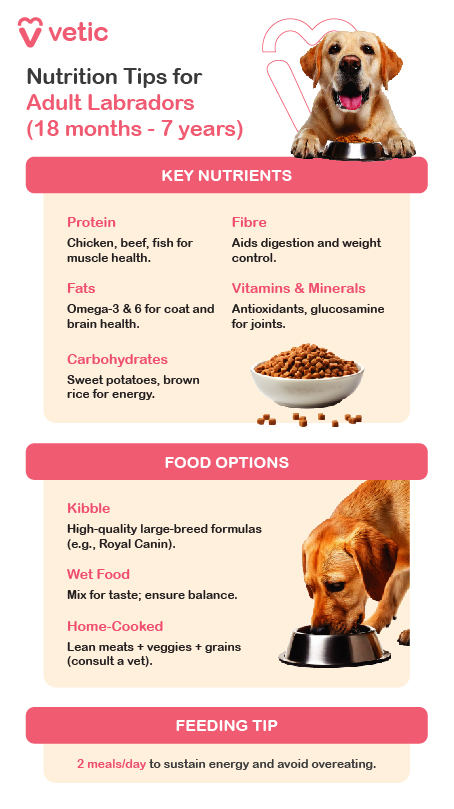
Nutrition for Adult Labrador Retrievers
Adult Labrador Retrievers, typically from 18 months to 7 years, require a diet that maintains their energy levels while preventing obesity. Their nutritional needs shift slightly from growth to maintenance, focusing on sustaining muscle mass, joint health, and an ideal weight.
Protein: Continue providing high-quality protein sources like chicken, beef, lamb, and fish to maintain muscle health.
Fats: Include healthy fats, particularly omega-3 and omega-6 fatty acids, to support skin, coat, and brain health.
Carbohydrates: Opt for complex carbohydrates like sweet potatoes, brown rice, and barley to provide steady energy.
Fibre: Incorporate fibre-rich foods to aid digestion and promote a healthy weight.
Vitamins and Minerals: Ensure the diet includes antioxidants (vitamins C and E), glucosamine, and chondroitin to support joint health, especially as Labradors are prone to hip and elbow dysplasia.
Food Options:
Commercial Kibble: Choose a high-quality adult dog food formulated for large breeds. Brands like Blue Buffalo, Wellness Core, and Royal Canin offer balanced options for adult Labradors.
Wet Food: Wet food can be mixed with kibble for added palatability, but ensure it’s nutritionally balanced.
Home-Cooked Meals: If you prefer homemade meals, balance lean meats with vegetables and whole grains. Consult a vet for appropriate recipes to ensure nutritional balance.
Feeding Frequency and Timing:
18 Months and Older: Feed 2 meals per day to maintain steady energy levels and prevent overeating.
Maintain a consistent feeding schedule, and avoid feeding right before or after intense exercise to reduce the risk of bloat, a condition that can be life-threatening in large breeds.
Labrador Retriever Adult: Vaccination and Deworming
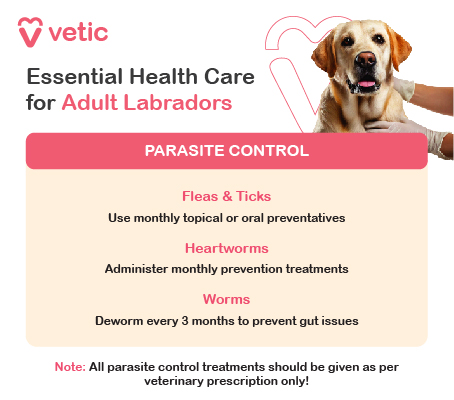
Vaccinations:
By adulthood, your Labrador should have received all core vaccinations. However, booster shots and optional vaccines may still be necessary.
Annual Boosters: Depending on your vet’s advice, your Labrador may require annual boosters for core vaccines (Distemper, Parvovirus, and Rabies).
Optional Vaccines: Based on your location and lifestyle, consider the vaccine for Bordetella.
Parasite Control:
Flea and Tick Prevention: Use monthly topical or oral preventatives to protect against fleas and ticks.
Heartworm Prevention: Continue monthly heartworm prevention treatments.
Worm Prevention: Adult dogs should be dewormed every 3 months to keep them free from worms. An overload of worms in the gut can cause serious illnesses including toxicosis.
Regular Vet Check-ups:
Schedule annual veterinary visits to monitor your Labrador’s overall health, weight, and dental condition. Regular blood tests may be recommended to catch any early signs of health issues.
Grooming Necessities and Frequency
Coat Care:
Labrador Retrievers have a short, dense double coat that sheds year-round, with increased shedding in the spring and fall. So, take your adult labrador for grooming frequently.
Brushing: Brush the coat 2-3 times a week with a slicker brush for deshedding tools to manage shedding and keep the coat healthy.
Bathing: Bathe your Labrador every 2-3 months or as needed. Use a mild dog shampoo that maintains the coat’s natural oils.
Ear Cleaning: Labradors are prone to ear infections, so clean the ears weekly with a vet-recommended cleaner, especially after swimming.
Nail Trimming: Trim the nails every 3-4 weeks to prevent overgrowth and discomfort.
Dental Care:
Dental cleaning is crucial for your pup’s overall health, including heart health. Brush your Labrador’s teeth 2-3 times a week using dog-specific toothpaste to prevent plaque buildup and gum disease.
Labrador Adult Health Risks and What to Watch Out For
Hip and Elbow Dysplasia, and Arthritis: Monitor for signs of joint discomfort, such as limping, stiffness, or reluctance to move. Early intervention can help manage these conditions.
Obesity: Labradors are prone to weight gain, which can exacerbate joint issues and lead to other health problems. Monitor your dog’s weight and adjust diet and exercise accordingly.
Ear Infections: Due to their floppy ears, Labradors are susceptible to ear infections. Regular cleaning and monitoring are essential.
Gastrointestinal Issues: Be cautious with your Labrador’s diet and avoid feeding table scraps to prevent digestive upset or more serious issues like pancreatitis.
Hypothyroidism: Labradors are at risk for hypothyroidism, which can lead to weight gain, lethargy, and skin issues. Regular vet visits can help detect and manage this condition.
Signs to Watch For:
- Decreased activity levels or reluctance to exercise
- Weight gain despite consistent feeding and exercise
- Persistent ear scratching, head shaking, or foul odour from the ears
- Vomiting, diarrhoea, or changes in appetite
- Behavioural changes such as increased aggression or anxiety
If any of these symptoms arise, consult your veterinarian for advice and potential treatment.
Labrador Retriever Adult: Activities and Behavioural Training
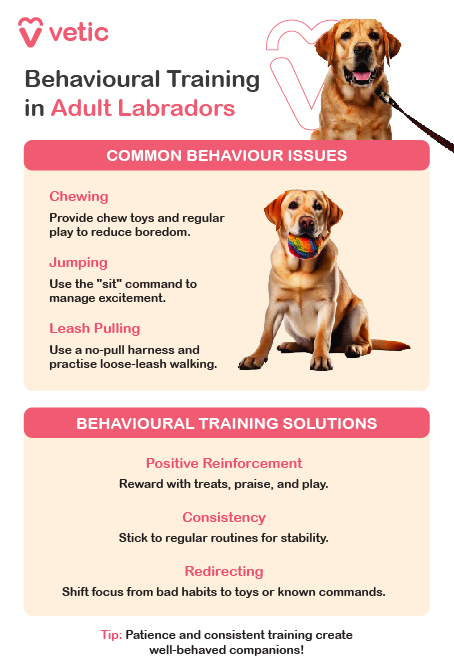
Physical Activities:
Adult Labradors are highly active and require regular exercise to maintain their physical and mental health.
Daily Walks: Provide at least 60 minutes of moderate to brisk walking daily, divided into 1-2 sessions.
Fetch and Play: Labradors love fetch, and it’s an excellent way to burn off energy. Use durable toys and vary the activities to keep them engaged.
Swimming: Continue to encourage swimming, which is a low-impact exercise that’s gentle on the joints while being highly effective in maintaining fitness.
Training:
Training remains essential in adulthood to reinforce good behaviour and provide mental stimulation.
Advanced Commands: Continue building on basic obedience with advanced commands like “wait,” “leave it,” and off-leash recall.
Agility and Obedience Training: Engage in structured activities like agility courses or advanced obedience classes to challenge their mind and body.
Socialisation: Regularly expose your Labrador to new environments and situations to maintain their confidence and prevent anxiety.
Mental Stimulation:
Provide puzzle toys, interactive games, and scent work to keep your Labrador mentally engaged, reducing the risk of boredom-related behaviours.
Behaviour Problems and Solutions

Common Behaviour Issues:
Chewing: Adult Labradors may continue to chew out of boredom or anxiety. Provide appropriate chew toys and engage in regular play to alleviate this behaviour.
Jumping on People: Labradors are friendly and may jump up on people out of excitement. Reinforce the “sit” command before allowing attention.
Pulling on the Leash: As strong adults, Labradors may pull on the leash during walks. Use a no-pull harness and continue practising loose-leash walking.
Behavioral Training Solutions:
Positive Reinforcement: Continue using treats, praise, and play to reinforce good behaviour. Avoid punishment, as it can lead to fear and anxiety.
Consistency: Maintain a consistent routine for feeding, exercise, and training to provide structure and reduce stress.
Redirecting: If your Labrador exhibits unwanted behaviour, redirect their attention to a toy or command they know.
Managing Separation Anxiety:
Labradors are social dogs and even adults can develop separation anxiety if left alone for long periods. Gradually increase the time spent apart, and provide enrichment toys to keep them occupied.
Labrador Retriever Senior: Nutrition, Health, Wellness and Preventive Care
Comprehensive Nutrition Guide for Elderly Labradors
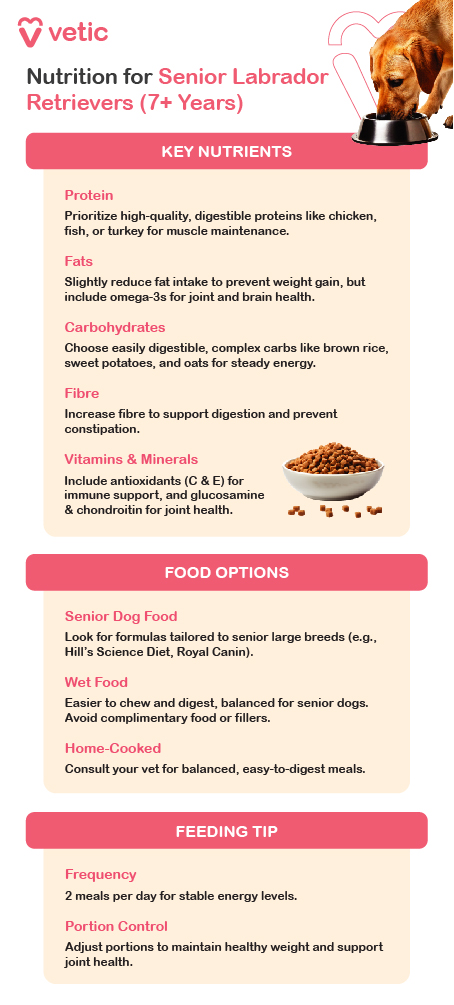
Nutrition for Senior Labrador Retrievers
Nutritional Needs: Senior Labrador Retrievers, typically from 7 years onwards, have unique nutritional needs to support their ageing bodies. A diet tailored to prevent obesity, support joint health, and maintain overall vitality is essential.
Protein: High-quality, easily digestible proteins like chicken, fish, or turkey should be prioritised to maintain muscle mass and overall health.
Fats: Reduce fat intake slightly to prevent weight gain, but continue providing essential fatty acids, particularly omega-3, for joint health and cognitive function.
Carbohydrates: Opt for easily digestible, complex carbohydrates like brown rice, sweet potatoes, and oats to provide steady energy.
Fibre: Increase dietary fibre to support digestion and prevent constipation, which can be more common in older dogs.
Vitamins and Minerals: Ensure the diet includes antioxidants (vitamins C and E) to support immune function, and glucosamine and chondroitin to maintain joint health. At this life-stage your dog might need additional nutritional supplements.
Food Options:
Senior Dog Food: Choose a high-quality senior dog food formula designed for large breeds. Brands like Hill’s Science Diet, Royal Canin, and Nutro offer tailored options for senior Labradors.
Wet Food: Wet food can be easier for seniors to chew and digest. Ensure it’s balanced and formulated for older dogs.
Home-Cooked Meals: If you prepare meals at home, consult with your vet to ensure the right balance of nutrients. Incorporate lean proteins, vegetables, and grains that are easy on the digestive system.
Feeding Frequency and Timing:
Continue feeding 2 meals per day to maintain steady energy levels and prevent blood sugar spikes.
Maintain a consistent feeding schedule, and monitor your Labrador’s weight closely. Adjust portion sizes as necessary to avoid weight gain, which can exacerbate joint issues and other health problems.
Grooming Necessities and Frequency for Senior Labradors
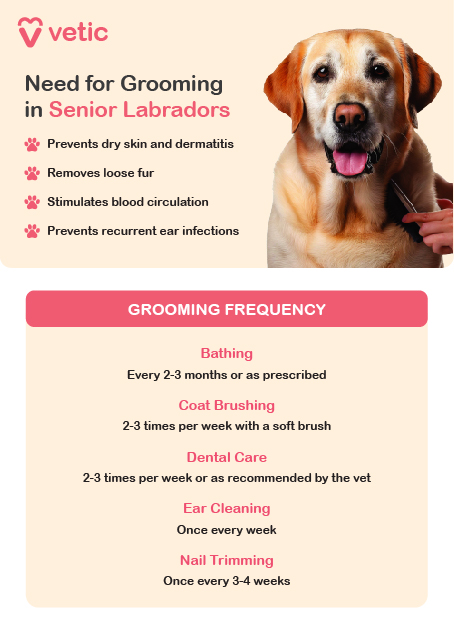
Coat Care:
Senior Labradors may experience changes in their coat, such as thinning or greying fur. Regular grooming remains important to maintain skin and coat health.
Brushing: Brush your Labrador’s coat 2-3 times a week to remove loose fur and stimulate circulation. Use a soft-bristle brush or grooming mitt for a gentler touch.
Bathing: Bathe every 2-3 months or as needed. Use a moisturising dog shampoo to prevent dry skin and dermatitis, which can be more common in older dogs.
Ear Cleaning: Continue weekly ear cleanings, as senior Labradors remain prone to ear infections, especially if they have been swimming.
Nail Trimming: Trim nails every 3-4 weeks or as needed, as reduced activity may lead to less natural wear.
Dental Care:
Oral health is critical in senior dogs. Brush your Labrador’s teeth 2-3 times a week to prevent gum disease and tooth loss. Consider dental chews or vet-approved dental treatments if brushing becomes challenging.
Labrador Retriever Senior: Complete Vaccination and Parasite Control
Preventive Care and Vaccination Schedule
Vaccinations: Senior Labradors should continue to receive essential vaccines, but your vet may adjust the schedule based on your dog’s overall health.
Parasite Control:
Flea and Tick Prevention: Maintain regular flea and tick prevention treatments, but consider formulations designed for senior dogs.
Heartworm Prevention: Continue monthly heartworm prevention, especially if your dog is still active outdoors.
Deworming: Keep your dog healthy and their immune systems in shape by continuing to deworm them every 3 months with age-appropriate dog dewormers.
Regular Vet Check-ups:
Senior Labradors benefit from more frequent veterinary visits. Schedule bi-annual check-ups to monitor for age-related conditions, such as arthritis, heart disease, or kidney issues. Your vet may recommend blood tests, urinalysis, and other diagnostic tests to catch potential problems early.
Health Risks of Senior Labradors and What to Watch Out For
Common Health Risks of Senior Labradors:
Arthritis: Watch for signs of stiffness, limping, or reluctance to move, particularly after resting. These can be signs of arthritis in dogs. Joint supplements, weight management, and medications can help manage this condition.
Obesity: Senior Labradors are more prone to weight gain due to reduced activity levels. Monitor their weight closely and adjust diet and exercise as needed.
Hypothyroidism: Signs include weight gain, lethargy, and skin issues. Regular vet visits can help diagnose and manage this condition.
Heart Disease: Keep an eye out for coughing, shortness of breath, or fatigue. Regular check-ups are essential to detect heart issues early.
Cancer: Senior dogs are at higher risk for various cancers. Regular check-ups and monitoring for lumps, bumps, or unusual symptoms are crucial.
Cognitive Decline (Canine Cognitive Dysfunction): Symptoms include disorientation, changes in sleep patterns, or increased anxiety. Mental stimulation and medications can help manage this condition.
Signs to Watch For:
- Increased stiffness or difficulty moving
- Sudden weight gain or loss
- Persistent coughing or breathing issues
- Changes in appetite or water consumption
- Unusual lumps or bumps
- Behavioural changes, such as confusion or increased anxiety
If you notice any of these signs, consult your veterinarian for a thorough evaluation and appropriate treatment plan.
Labrador Retriever Senior: Activity and Behaviour Training
Activities, Exercise, and Training
Physical Activities: While senior Labradors may not have the same energy levels as their younger selves, regular exercise is still crucial to maintain mobility, manage weight, and promote mental well-being.
Daily Walks: Continue with daily walks, but reduce the intensity and duration if your dog shows signs of fatigue. Aim for 20-30 minutes per session, twice a day.
Swimming: Swimming remains an excellent low-impact exercise that is gentle on ageing joints while keeping your dog active.
Gentle Play: Engage in gentler play activities like fetch, but avoid high-impact exercises that could strain joints.
Training: Training during senior years helps keep your Labrador’s mind sharp and reinforces good behaviour.
Refresher Commands: Regularly practise basic obedience commands like “sit,” “stay,” and “come” to keep your dog mentally engaged.
Adaptation Training: Adjust training to accommodate any sensory decline (like hearing or vision loss) by incorporating hand signals or touch commands.
Mental Stimulation: Provide senior-friendly puzzle toys and scent games to stimulate your Labrador’s mind. Regular mental exercise can help delay cognitive decline and reduce anxiety.
Behaviour Problems and Solutions for Senior Labradors
Common Behaviour Issues:
Separation Anxiety: Senior Labradors may develop or experience worsening separation anxiety due to cognitive decline or increased dependency. Provide a calm, secure environment and consider anti-anxiety treatments if needed.
House Soiling: Older dogs may have accidents due to cognitive decline or health issues like incontinence. Increase potty breaks and consult your vet if the issue persists.
Increased Vocalization: Cognitive decline can lead to increased barking or whining. Ensure your dog is comfortable and use gentle redirection or calming techniques to reduce stress.
Behavioral Training Solutions:
Gentle Training: Use gentle reinforcement techniques to address any behaviour issues. Avoid punishment, as it can increase anxiety and confusion.
Routine: Maintain a consistent routine for feeding, exercise, and sleep to provide stability and reduce stress.
Comfort and Security: Ensure your Labrador has a comfortable place to rest, free from drafts or noise. Consider using calming products like pheromone diffusers if your dog seems anxious.
Managing Cognitive Decline: For Labradors showing signs of cognitive dysfunction, incorporate brain games, interactive toys, and regular mental stimulation to slow the progression. Your vet may recommend medications or supplements that support brain health.
What You Should Remember About The Labrador Breed
Labrador Retrievers are remarkable companions, known for their affectionate nature, intelligence, and boundless energy. From playful puppies to loyal adults and gentle seniors, they bring joy at every life stage. Each phase of their life comes with unique needs—proper nutrition, regular exercise, consistent training, and attentive health care.
Pet parents must be vigilant about common issues like obesity, joint problems, and age-related concerns, ensuring their Labrador thrives physically and mentally.
Adopting a Labrador is a lifelong commitment filled with responsibilities and rewards. They rely on you for love, care, and companionship through every milestone. By providing a nurturing environment, regular veterinary check-ups, and plenty of patience, you can help your Labrador lead a happy, healthy life.

